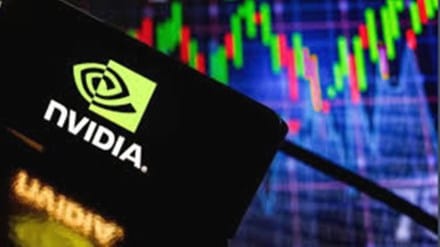Nvidia’s third-quarter earnings will be a significant test for the recent artificial intelligence (AI) boom that has taken the market by storm. Bellwether Nvidia will announce its 3rd-quarter financial results for FY26 on November 19 after market close.
Semiconductor giant Nvidia has become the first company to surpass a market value of $4 trillion. Currently, with a market cap of $4.67 trillion, Nvidia trades around $118, up nearly 40% YTD.
Nvidia’s results are expected to significantly influence sentiment on AI and tech stocks and on broader market indices. Nvidia stands as the proxy for the AI industry today and the results are expected to have a significant impact on Wall Street as well.
“The stock’s average move after earnings release is +/- 7.4%, so just an average move will make an impact on the entire market,” says Jay Woods, Chief Market Strategist, Freedom Capital Markets.
Financials and Outlook
NVIDIA’s outlook for the third quarter of fiscal 2026 shows that revenue is expected to be $54.0 billion. The company has not assumed any H20 shipments to China in the outlook, as has been the case in Q2.
The H20 chip, designed for the Chinese market, faced export restrictions earlier this year until a deal was struck between Huang and President Donald Trump in August, allowing export licenses in return for 15% of sales made in China.
If and when President Trump approves the route to China, Nvidia may see its next significant increase. “Most analysts have assigned zero value in their models to any positive momentum from Nvidia’s partnerships or sales into China. If Nvidia reports progress there, that would be a meaningful upside surprise,” Brian Leonard, PM at Keeley Gabelli Funds.
GAAP and non-GAAP gross margins are expected to be 73.3% and 73.5% respectively, and GAAP and non-GAAP earnings per diluted share were $1.08 and $1.05, respectively.
The Q2 results of Nvidia showed revenue of $46.7 billion, up 6% from Q1 and up 56% from a year ago. The Data Center revenue was $41.1 billion, up 5% from Q1 and up 56% from a year ago, while the Blackwell Data Center revenue grew 17% sequentially.
“As the largest company in the world, Nvidia has many levers to pull when it comes to earnings—Q3 results, full-quarter sales, or earnings per share—and they typically find a way to satisfy expectations. It’s possible they could beat on revenue, report better-than-expected margins (perhaps around 2% higher), and address concerns about the energy bottleneck expected to slow growth in the 2026–2028 window,” says Brian Leonard, PM at Keeley Gabelli Funds.
Nvidia is expected to report third-quarter earnings of $1.25 per share and $54.9 billion in sales, reflecting a 56% year-over-year increase. Analysts also anticipate guidance for the January quarter at $61.44 billion, signaling a reacceleration of growth, reported CNBC.
The demand for Nvidia’s products seems to be robust. In October, Nvidia CEO Jensen Huang had announced that untill 2026, the company has already received over $500 billion in orders for its Blackwell and Rubin chips.
Nvidia has also been signing several deals with other AI giants. Nvidia has agreed to invest up to $10 billion in OpenAI equity, with OpenAI purchasing 4 to 5 million GPUs over several years. Additionally, Nvidia will invest $5 billion in Intel. Nvidia also invested $1 billion in Nokia to enhance cellular network hardware with its GPUs and is also investing in startups.
Caution Ahead
Nvidia is probably one of the most watched and closely tracked stocks currently. Pressure surrounding margins is crucial, as Nvidia has shown notable profitability. Investors will likely scrutinize each aspect from margins, profitability to data-centre contributions, Blackwell adoption rates, order flows, and comments on tightening export regulations.
“US equity futures are advancing alongside tech shares ahead of Nvidia’s earnings Wednesday, as investors now face a moment that demands sharper attention”, warns Nigel Green, chief executive of global financial advisory giant deVere Group.
A minor setback in any of these areas could quickly alter market sentiment, particularly following Nvidia’s strong share-price performance.
“The company’s new Blackwell platform, relentless spending by hyperscalers, and sovereign-level AI projects have fuelled broad optimism that Nvidia will not only beat expectations but set a stronger tone for year-end guidance. Yet this is precisely why caution is intensifying,” adds Green.
The AI industry has experienced multi-billion dollar deals, including those referred to as ‘circular deals’ among major players. The market is approaching a stage where questions regarding monetization are expected to be asked. “Nvidia earnings, incidentally, once again stand as a major macro risk, as enthusiasm around the whole AI frenzy seems to ebb, with the market having shifted from an ‘all capex is good capex’ mood, to one where whether firms are actually able to monetise that expenditure has become the million (or more!) dollar question.”
